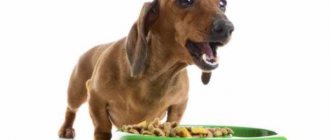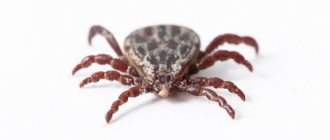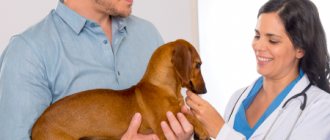If a dog has little milk, then its puppies may die of starvation or be delayed in development. No less dangerous is too much lactation, which can lead to an inflammatory reaction in the mammary glands.
During the period of breastfeeding, the owner of a four-legged pet requires increased care, since any deviation from the norm can affect the health of both mother and babies.
How to tell if your dog has low milk supply
In the first hours and days after birth, colostrum begins to be produced in the mammary glands of mammals. The secret is highly nutritious milk with a high content of immunoglobulins, vitamins, proteins and complete amino acids. Colostrum is a natural immune defense for newborns from pathogenic microbes and viruses, protecting the baby’s body from infections in the first days and even months after birth.
Approximately 3-4 days after the birth of the offspring, the secretion of the mammary glands becomes similar to cow's milk. Its composition contains approximately 2 times more fat than whole cow's milk. For newborns, it is the source of all nutrients and is well absorbed by puppies.
The absence (agalactia) or insufficient amount of milk (hypogalactia) in a domestic dog is not so difficult to recognize. As a rule, the problem is indicated by the behavior of the offspring. Well-fed newborns are not fussy, but calm, sleeping almost all the time, huddling together near the warm belly of their mother. Hungry puppies become active, crawl around the nest in search of food, and squeak a lot.
An owner can also suspect hypogalactia in a dog based on thinness or lack of weight gain in the offspring, with regular monitoring of the newborn's live weight gain.
The problem with a lack of milk secretion is indicated not only by the behavior of the puppies, but also by the mother herself. The dog can leave the nest for a long time, when trying to suckle, it runs away from the babies, sometimes even showing aggression towards them. This behavior is associated with pain when puppies suck on empty mammary glands.
The owner can make sure that the dog has no milk on his own by pressing on the milk nipples. Their examination reveals cracks and roughening. A change in secretion (watery or mucous discharge, abnormal color) may indicate that the animal has mastitis.
We recommend reading about uterine prolapse in dogs. You will learn about the causes of uterine prolapse in an animal, symptoms, diagnostic methods, treatment and care. And here is more information about the symptoms and treatment of vaginitis in dogs.
[custom_ads_shortcode1]
Symptoms of diseases of the gastrointestinal tract
Signs of gastrointestinal diseases depend on the type of disease and the cause of its occurrence. One of the main symptoms that most clearly signals the presence of gastrointestinal diseases is pain.
The location of the pain may indicate the following problems2:
- heaviness after eating or abdominal discomfort may be associated with a lack of digestive enzymes in the intestines;
- pain in the upper third of the abdomen can be associated with inflammation of the walls of the stomach, intestines and lower esophagus or appear with ulcerative lesions of the stomach and duodenum. Additional symptoms of these diseases are nausea and vomiting;
- pain in the right hypochondrium often signals inflammation of the gallbladder - cholecystitis;
- pain in the left hypochondrium may be a sign of gastritis and other inflammatory diseases of the gastrointestinal tract. If the pain is severe and girdling in nature, then during the examination the doctor pays special attention to the condition of the pancreas;
- pain in the lower abdomen can be a sign of appendicitis and intestinal infections.
Most gastrointestinal diseases are not limited to abdominal pain. A person may also be bothered by 2: Diarrhea. In chronic form, it may indicate hepatitis, cholecystitis, pancreatitis and colitis; Constipation. Gastroenterologists call constipation bowel movements less than 3 times a week. This symptom often accompanies dysbiosis, irritable bowel syndrome; Flatulence. Excessive accumulation of gases in the intestines and stomach can be associated with colitis, pancreatitis and dysbiosis; Nausea and vomiting; Frequent attacks of heartburn, which are caused by gastroesophageal reflux or gastritis with high acidity.
Causes of lactation problems
According to veterinary experts, the following reasons can cause agalactia or insufficient production of milk secretion in an animal:
- The animal has given birth for the first time . Lack of milk in a primiparous female is a fairly common phenomenon associated with the slow production of hormones that stimulate milk production. The stress that dogs experience when encountering unusual sensations in their bodies for the first time also delays the normal production of secretions by the mammary glands.
- Complicated labor . Difficult labor, significant blood loss, and the use of antispasmodics are factors that provoke agalactia and insufficient milk production. The cause of impaired secretion may be a caesarean section performed on the animal.
- The reason for the lack of milk in a new mother is often diseases of the genital organs (endometritis, vaginitis, inflammation or ovarian cyst, etc.). Under the influence of inflammatory and hormonal factors in the dog’s body, the processes of milk production and separation are disrupted.
- Disturbances in the feeding system of a pregnant female. Inadequate diet, low quality feed, lack of vitamin A, E, and ascorbic acid in the diet negatively affect milk production in the female who has given birth.
- Unsatisfactory living conditions for the animal . The lactation process can slow down significantly if the dog is kept in a cold, damp, unheated room.
Veterinary experts note that agalactia or insufficient milk production is often caused by certain medications used to treat a dog during pregnancy.
[custom_ads_shortcode2]
The mechanism of formation of false lactation
This phenomenon can be observed within a couple of weeks after mating. Neither the age of the animal nor the breed matters. In addition, this anomaly occurs after estrus, without the participation of the male dog.
To explain why milk is produced, we need to remember that lactation occurs under the influence of hormones: estrogen, prolactin, oxytocin, progesterone. The latter is called the pregnancy hormone. It is produced by the corpus luteum of the ovary, a gland that forms after ovulation. Progesterone and prolactin stimulate the enlargement of the mammary glands, regardless of whether pregnancy has occurred or not. These 2 substances are the main “culprits” of false pregnancy.
When there is a hormonal imbalance, the corpus luteum produces lactogenic hormones in excess. As a result, progesterone levels increase, signs of pregnancy appear and false lactation develops. The corpus luteum lives and produces the hormone for 60-70 days, maintaining the appearance of pregnancy.
What to do to increase milk supply for a nursing dog
When faced with the problem of insufficient milk production in a pet that has given birth, the owner should take the following measures to restore it:
- Stimulate milk production by developing the mammary glands. The last pair of nipples is the most productive. If the litter is large, then the healthiest and tallest puppies should be placed near the first nipples so that they develop them and thereby increase milk production. The owner can also regularly massage the dog’s mammary glands on his own.
- You can increase secretion production by including certain foods in your animal’s diet. First of all, the dog should be fed liquid food. It is necessary to increase the amount of liquid consumed by the pet - water, milk. To stimulate milk production, experienced breeders give the new mother cow's milk and honey.
- Walnuts have a milk-containing effect. They should be given one three times a day. The dog's diet should contain dairy products - cottage cheese, fermented baked milk, natural yogurt. According to experienced dog breeders, the use of biogenic stimulants, such as Apilac, has a good effect.
- On the recommendation of a veterinarian, the animal may be prescribed hormonal medications. Oxytocin is most often used to activate the milk production process in obstetric practice. The hormonal substance stimulates the formation of milk in the dog’s mammary glands and relieves pain when puppies suck.
In some cases, the inclusion of calcium supplements in the diet helps to activate milk production. The mineral is lost by the mother's body during pregnancy and often leads not only to postpartum eclampsia, but also affects milk production after the birth of the offspring.
[custom_ads_shortcode3]
Helping a falsely lactating dog
At the first appearance of lactation without pregnancy, the owner can help the pet on his own. To do this you need to do the following:
- Prescribe a low-calorie diet. The diet is reduced by 2 times. Limit drinking: give water no more than 3 times a day. When eating natural foods, products that stimulate lactation are excluded from the diet: milk, cottage cheese, meat, offal, fish.
- Increase your walking time and physical activity.
- Remove soft toys, slippers, socks and other items that the dog may mistake for puppies.
- Wear a special collar that limits access to the mammary glands if the female suckles herself.
When neuroses manifest, they give sedatives in the form of tablets or suspensions: Fontex, VetSpokoin, Kot Bayun, Fitex, Stop Stress, Fospasim. The listed measures stop lactation within 3-5 days.
Important! Even with severe swelling of the mammary glands, you cannot massage or express milk. It is better to lubricate the nipples with camphor oil and wrap the stomach with an elastic bandage.
Professional help is sought if complications arise: fever, refusal to eat, purulent discharge from the nipples, unsatisfactory condition of the dog. In such cases, in addition to diet therapy, hormonal drugs and corticosteroids are prescribed.
If false pregnancy has not occurred for the first time, the dog should be examined by a veterinarian in order not to miss the development of complications. If this happens, specific treatment with antibiotics and other drugs is prescribed. Some pills have strong side effects, so therapy should be carried out under the supervision of a doctor.
In case of repeated cases of imaginary pregnancy, the appearance of tumors in the mammary gland, or the development of pyometra, castration is the only method of treatment.
How to feed puppies if lactation cannot be established
In the case when the dog cannot quickly restore milk production, or the mother’s milk is not enough for the babies, the owner needs to take care of feeding the puppies. The best substitute is a specialized mixture for newborn puppies. You can buy powdered milk at a veterinary pharmacy or pet store.
A substitute product, for example from Royal Canine, is usually a set of dry mixture, a bottle with marked divisions, a measuring spoon for the correct dosage and several nipples of different sizes.
If there is no special formula for newborn puppies, you can feed the babies with boiled cow's milk. For half a liter of whole product, add one chicken yolk and 100 ml of cream. Many dog breeders successfully feed newborns with goat milk.
You can also add one beaten chicken yolk to it. When feeding puppies natural milk, you should boil it and carefully monitor the baby’s intestinal function.
Feeding puppies with formula milk Ready-made formulas for children are suitable for artificial feeding. Taking into account the fact that bitch's milk is fatty, infant formula must be diluted not in water, but in boiled cow product.
The prepared substitute should be fed warm. The frequency of feeding depends on the age of the babies. In the first 7 days of life, puppies should receive another portion of food every 2 hours. When babies are 2 weeks old, they are fed 10 times, at the age of three weeks - 8 times a day.
When using a ready-made specialized mixture, the instructions provide detailed feeding schemes for various breeds of animals (multiplicity, serving size). If whole cow's or goat's milk or infant formula is used for artificial feeding, then the owner needs to control the weight gain of the young animals using special tables for a particular breed.
We recommend reading about why a dog won't eat. You will learn about how to normalize your pet’s appetite, why your dog doesn’t eat after giving birth, refuses dry food, meat, and more. Find out more about optimal dog nutrition here.
The strength of lactation in a dog after birth depends on a number of reasons. In some cases, the owner is able to quickly establish the process of milk production by including special supplements in the diet or using medications on the recommendation of a veterinarian. However, a responsible dog owner should be prepared to bottle-feed newborns using special formula or whole milk.
[custom_ads_shortcode1]
Additional terms
Puppies that cannot suckle on their own are tube fed. However, this procedure requires a lot of skill, and without special training it is life-threatening. You can’t just pour milk into your mouth, because it gets into the respiratory tract, blocking it.
It is very important that babies do not freeze because their bodies do not yet regulate temperature well. Hypothermia occurs quickly, causing death. Under normal conditions, they bask near their mother or crawl away from her when it gets hot. Therefore, it is necessary to provide a source of heat so that metabolic processes do not slow down and the body does not die. The room should be 28–320C during the first month of life, 250C thereafter.
You can buy a special incubator or build it yourself. To do this, you need a large box and a heating pad with warm water. To prevent your offspring from getting burned, you must check the temperature. And to avoid overheating, they leave the opportunity to crawl away. If babies are hot all the time, heat stroke occurs due to lack of fluids, leading to death.
Replace the heating pad with a regular incandescent lamp, which is installed above one of the corners of the box. The other side should remain in the shade to cool down. It warms the human body well; for this you need to keep small dogs in the stomach area. However, this method is inconvenient for the owner who needs to do other things.
Useful video
Watch this video about artificial feeding of puppies and kittens:
Feeding a dog that has given birth to puppies is not just an important, but also a responsible process, since the owner of the animal, on the one hand, should make sure that the mother has a lot of high-calorie milk, rich in everything necessary for the formation of strong immunity in babies, and on the other — so that the bitch herself is not exhausted, feels cheerful and healthy.
[custom_ads_shortcode2]
We monitor our weight
When feeding a newborn puppy, you need to monitor the baby’s weight and track how much he can eat in one feeding. Regular baby scales will do.
It is normal not to gain weight in the first few days after birth. It's normal to lose up to a third of your body weight:
- at the age of up to 6 days – from 15% to 20%;
- at the age of 7-13 days – from 22% to 25%;
- at the age of 14-20 days – from 30% to 32%.
Don't worry about being underweight. You need to contact a veterinarian in 1-2 days if the situation does not improve.
Feeding a newborn puppy is a big responsibility. If there are several kids, then the task becomes much more complicated. But a caring owner will do everything to ensure that the puppies do not suffer from hunger and disease and grow into big, happy dogs.
Interesting topics
What else to read:
- Birth of a puppy, first aid, careContents of the articlePreparing for childbirthFirst aid for an animal during childbirthHelping a dog in.
- Early socialization of a puppy Contents of the article Why you need to socialize a dog Three stages of early socialization First stage Second stage Third.
- How to choose toys for a puppy and how to play with him Contents of the article Why does a puppy need toys Types of dog toys How to choose toys for a puppy Play with.
- What to do if the puppy is picky about food Contents of the article Why is the puppy picky? Possible reasons How to correctly change the brand of food We adjust the food.
© Veterinary clinic "Belanta", 2004—2021, Moscow
What to feed a nursing mother dog in the first month
Owners of different dogs often ask essentially the same questions: What to feed a nursing Spitz bitch? What to feed a nursing Labrador dog? Or: What to feed a Yorkie after giving birth? By and large, the diet of a bitch of any breed after giving birth is almost the same. The menu of a new mother must include:
- fish,.
- meat,.
- by-products.
- cereals.
- dairy products and milk.
- vegetables.
Don't forget about vitamin and mineral supplements either. Very often, a dog does not eat well after giving birth. There is no need to worry about this, because the loss of appetite lasts for a couple of days. However, you still need to feed the animal at intervals of six or eight hours and be sure to give it something to drink to increase lactation. In the first week, it is necessary to increase the amount of food for a nursing mother by one and a half times. During this period, the dog’s diet should include cottage cheese and milk, porridge (oatmeal or semolina), boiled fish, meat broth with rice, boiled chicken or beef. Don’t forget about vitamins for pregnant and lactating dogs. During the second week of feeding, you can add unprocessed meat to your dog’s menu, and in the third week you need to make the food varied (with the addition of fresh vegetables, herbs, bone meal, vitamins), and most importantly - abundant. The amount of food increases depending on the number of puppies in the litter (four puppies - twice as much food, eight - three times as much). If you don’t know how to increase milk in a nursing dog, you can give her milk with honey or Apilak tablets (one piece four times a day) as a drink. From the fourth week, you should, while maintaining the calorie content of food, reduce its amount, because the puppies are already beginning to receive complementary foods.
[custom_ads_shortcode3]
Homemade breast pump
What should you do if you need to express milk from a dog, but there is no special device? You can, of course, use a female breast pump, but choosing a model that fits the size of a dog, especially a small one, is very problematic.
The second option is to make this tool yourself. In fact, the home breast pump is very similar to the one described above. It is a syringe that is selected depending on the size of the pet.
Instead of a needle, a plastic tube from a dropper is put on the syringe. The piston is removed, and a spray gun with a trigger is attached to the other end of the plastic tube.
The hole for the piston is pressed tightly against the animal's nipple. They press the nozzle (from a spray bottle, for example), and the milk is drawn into the syringe. And then they proceed as described above.
Food for nursing dogs
Feeding a dog during lactation is quite a troublesome task. Not every dog owner has the time, energy and money to count calories, select and prepare the necessary products for the animal. And here special dry food for nursing dogs will come to the rescue. This food is available in the food line of almost every well-known dog food manufacturer. This food already contains an optimal feeding formula, has an increased amount of proteins (animal and plant origin), adjusted fat content and the required dose of vitamins. All that the owner of a nursing mother needs is to increase the amount of food (double from the second week and triple from the third to the end of feeding the puppies), and also divide this amount into five to six meals.
If the owner decides to adopt a female dog, then he must be prepared for all the intricacies of the period of her motherhood. An important point is to stop the bitch's lactation after the puppies are distributed. This is necessary in order to avoid mastitis and its complications. So, let's learn about what needs to be done to stop lactation, that is, the release of milk from the mammary glands of a bitch.
[custom_ads_shortcode1]
How to end the suckling period correctly
From about four weeks of age, puppies begin to be fed liquid food. The period is reduced to 2.5 if they are not gaining weight well. At this age they can already lap from a saucer. The baby is ready to introduce complementary foods if:
- sees well;
- moves easily;
- active;
- development corresponds to the norms for the breed;
- stopped gaining weight or the weight gain decreased significantly.
The transition should be smooth, first they give liquid porridges, gradually increase their thickness, begin to introduce solid, then dry food. The number of receptions is 3-4. Make sure the food is warm and prepare it fresh every time. To provide the growing body with all the useful substances, it is recommended to buy special food for puppies.
Dry food is introduced gradually at two months of age, after which it is transferred to a two-time diet. Be sure to check the cleanliness and availability of water in the bowl.
Features of breastfeeding puppies
After the mother gives birth to her offspring, her mammary glands begin to function intensively. In the first days, colostrum is released from them - a lighter and healthier food product for puppies than milk. It is easier to digest by the dog’s weak body and helps him quickly adapt to extrauterine nutrition, that is, to mother’s breast milk. By the way, it is twice as fat as cow's milk.
The quantity and quality of milk is affected by the dog's diet. The healthier and more natural her food is, the better her lactation will be and, accordingly, the faster the puppies will grow.
They eat from two rows of nipples located on the mother's abdomen. A dog can have from eight to twelve mammary glands in total, but the lower nipples are always the milkiest. Only her children can determine whether a mother has enough milk.
If they have enough maternal nutrition, then they grow before our eyes, are calm and always huddle together after feeding. When a bitch does not have enough milk, the problem is indicated by the puppies squeaking, their poor weight gain, and anxiety.
[custom_ads_shortcode2]
How to maintain good hygiene
Newborn dogs can die not only from exhaustion, hypothermia or overheating, but also from pathogenic bacteria that multiply abundantly in a polluted environment. Their urination is uncontrollable, so the litter very soon becomes filled with waste. It needs to be changed, and the offspring should be wiped with a warm, damp cloth, simulating licking. This type of massaging of the abdominal area should be done before and after feeding to improve digestion.
Check your skin daily for diaper rash. Baby cream will help get rid of them.
Although the freshly prepared mixture can be stored in the refrigerator for up to 24 hours, leftovers after eating should be discarded immediately, regardless of volume. The container and nipples are washed with warm water, dirt is cleaned with soda or salt and a brush. Detergents cannot be used - they form a thin, indelible film that is detrimental to health.
The feeding kit for newborn puppies is then sterilized in a special device or boiling water. The cleanliness of the dishes must be carefully monitored, because intestinal bacteria are very dangerous for a fragile digestive system and can lead to the death of the puppy. Store it in boiled water until next use.
The lack of antibodies normally found in breast milk leads to a weakened immune response. Pets are very vulnerable to most diseases; their health needs to be monitored more closely.
Duration of lactation in dogs
This process usually lasts from six to eight weeks in bitches. Veterinarians do not recommend artificially interrupting such an important period, which is why breeders do not separate puppies from their mother until two months. After eight weeks, the mother independently reduces feeding time and spends less time with her offspring. That is, nature has laid down the process of gradual cessation of lactation as puppies grow older.
It is precisely this gradual weaning of the female offspring from the breast that will never cause stress and digestive problems in babies. Young dogs will grow up becoming familiar with regular foods or foods specially designed for them.
[custom_ads_shortcode3]
Preparing for feeding
Before feeding, your puppy's temperature should be measured. If the temperature drops to 35.5 degrees, the baby is pre-warmed. Otherwise, his gastrointestinal tract will not cope with the load. The easiest way is to warm up under a jacket with the heat of your own body, but this process can take up to three hours. While the puppy is warming up, if necessary, he is given a glucose solution.
Another important procedure before eating is massage. Mom licks her offspring, massaging their tummies and starting their work. Take damp cotton wool and wipe the baby - girls around the navel and genitals, and males - in the direction from the navel to the penis. In the absence of massage, the patient faces stomach problems.
A few more rules:
- the prepared mixture is not stored, it is diluted anew each time;
- before feeding, wash your hands with soap and boil the bottle for 5-15 minutes;
- check the temperature of the mixture by dripping on your wrist - it should be 38-40 degrees.











